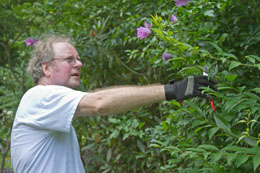The best time of the year to prune a rose of Sharon, is during the spring. Take a look at these additional pruning tips when it comes to this lovely plant.

Rose of Sharon, a hardy perennial that will create an environment of endless beauty in your garden. This plant is a deciduous shrub and bush that can grow to about 8 to 10 feet tall. They produce stunning flowers that are either purple, pink, blue, or white in color. They are belong to the hibiscus family and are very popular in the northeastern parts of the US. Taking care of this plant is a cinch, where the following pruning tips will ensure that it blooms for a long time to come.
Pruning a Rose of Sharon
Young Plant
This hardy plant grows well in USDA-approved zones 5 to 9. They grow well in full and partial sunlight areas, where the soil needs to be well-drained for it to thrive. Surprisingly, a rose of Sharon doesn't need pruning as long as there is plenty of space for it stretch and grow. However, if you want it to look in shape and not wild in your garden, then the best time to prune them is in
late March to early May.
To prune the plant, you'll need hand pruners, a pruning saw, loppers, bleach, and gloves. You'll need to use 1 part of bleach and 9 parts of water to clean your gardening tools to avoid the spread of plant diseases, and transferring insects. Remember, if you live in cold climatic conditions, you need to carry out this task during late winter or early spring. First, you need to remove any dead or diseased parts of the plant; cut them down to the ground. Then, thin out the crowded stems at the base; you can cut them back to 2 buds. This will help encourage growth of larger flowers.
Mature Plant
Breathe life into your plant by pruning one third of its mature stems. You need to prune them to the ground every spring for a period of 3 years. By the time your plant is 3 years old, you will find that it has been restored to a new flowering plant.
When Not to Prune a Rose of Sharon
Avoid pruning this plant in the fall, since this is when the plant's growth slows down. Also, as it is a deciduous tree, it will lose most of its leaves during this season. The plant blooms all summer right through early fall, ultimately ceasing once the latter season arrives. You should carry out heavy mulching during the fall and use burlap around the bush, shrub, or tree. This will help provide the roots with insulation during the winter.






 Rose of Sharon, a hardy perennial that will create an environment of endless beauty in your garden. This plant is a deciduous shrub and bush that can grow to about 8 to 10 feet tall. They produce stunning flowers that are either purple, pink, blue, or white in color. They are belong to the hibiscus family and are very popular in the northeastern parts of the US. Taking care of this plant is a cinch, where the following pruning tips will ensure that it blooms for a long time to come.
Rose of Sharon, a hardy perennial that will create an environment of endless beauty in your garden. This plant is a deciduous shrub and bush that can grow to about 8 to 10 feet tall. They produce stunning flowers that are either purple, pink, blue, or white in color. They are belong to the hibiscus family and are very popular in the northeastern parts of the US. Taking care of this plant is a cinch, where the following pruning tips will ensure that it blooms for a long time to come.